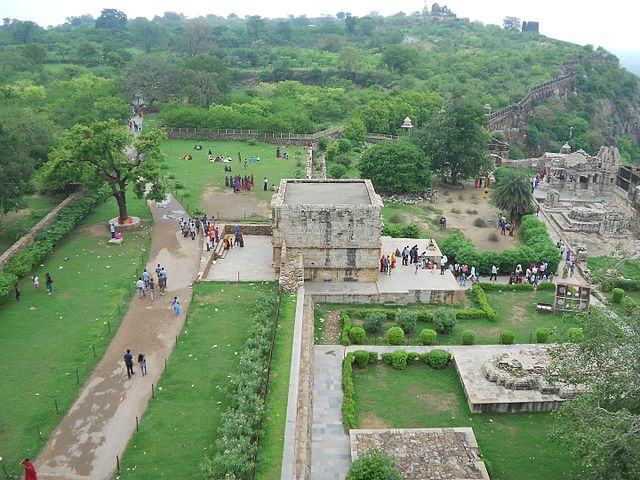
(1) India had been ruled by number of dynasties. The kings believed in royal style of living and constructed number of forts which sparingly dotted the state. In India, Rajasthan is the major state which beholds number of forts. Watching these forts in India would be a sheer pleasure as you would come across a phenomenal mix of Rajputana and Mughal architecture, Reference-Image: Chittorgarh Fort, One of the most impressive sights in Delhi is the Red Fort, otherwise known as Lal Qila. Built in 1639 by Emperor Shah Jahan, this Fort has been a mute witness to innumerable conspiracies, scandals, battles in it’s time. The Red Fort was declared a UNESCO World Heritage Site in 2007. The Red Fort is a brilliant show of Architecture with its Islamic inspired octagonal shape and rampart walls covering a perimeter of 2.41km. Completed within a span of nine years, its construction cost about ten million rupees, most of it going towards the building of the palaces with the fort. The main entrance to the Lal Quila is through the Lahori Gate.

Beyond the gate, there is a roofed passage, flanked by arcaded apartments leading to the palaces, known as Chhatta Chowk. These apartments are now used as shops. The Fort included a number of buildings with it like the Mumtaz Mahal Palace, Moti Masjid mosque and many splendid halls and structures. Unfortunately some do not

stand as they (2) were centuries ago and are in ruins. Pearls in the necklace of the castles of Hind, this sprawling fort is the witness to glorious battles and the rule of the Maharajas of Gwalior. The fort is located at Gopalchal and has earned the reputation of North and Central India's most impregnable fort. It is one of the most invincible forts of India and has an impressive citadel. It was constructed on the hill of sandstone and it towers 10 km from the plain. This fascinating fort is one of its kind and you should make sure that you view the best of Gwalior fort. One of the finest in

the country, (3) the Jaisalmer fort is located bang in the middle of the Thar Desert in the State of Rajasthan. Built in 1156, its literal meaning ‘abode of the dead’ the Jaisalmer Fort is rather incongruous given the desolation around it. Its massive yellow sandstone walls are a tawny lion color during the day, turning to a magical honey-gold as the sun sets and camouflages the fort making it appear a part of the picturesque yellow desert which is why it is also known as the Golden Fort. This splendid Rajput fort built by the ruler Rawal Jaisal is one of the largest of desert forts of the world. With 3 solid layers of walls the fort contains the Raj Mahal (Royal palace), Jain temples, Laxminath temple, 4 massive gateways and merchant havelis (large houses built by wealthy merchants in Rajasthani towns and cities in North India, with beautiful, ornate sandstone carvings). Just as the Taj Mahal in Agra is worth visiting on a full moon night, Jaisalmer fort by nightfall is a sight to
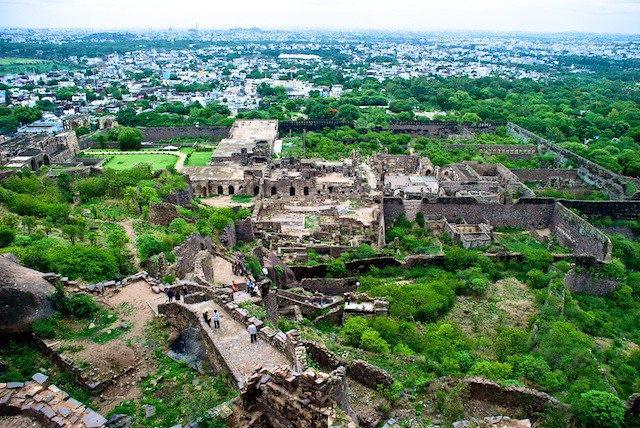
behold and experience. (4) This Deccan Fort built atop a granite hill is known for its magical acoustic system. Also referred to as Golkonda constructed by the Qutub Shahi kings in the 13th centaury. The wonderful acoustic system of Golconda fort speaks volumes about the architecture of the fort. This majestic structure has beautiful palaces and an ingenious water supply system. Sadly, the unique architecture of the fort is now loosing its charm. Golconda is also known as ‘Shepherd's Hill’ or ‘Golla Konda’, in Telugu. According to a legend, a shepherd boy found an idol on the rocky hill called 'Mangalavaram'. This news reached the Kakatiya king, who was then ruling Golconda. He ordered the construction of a mud fort around the holy spot. Later, the fort was expanded by the Qutub Shahi kings into a huge structure made of granite. The highlight of the Golconda fort today is the sound and light show which depicts the glorious past of this grand fortress. This audio - visual extravaganza is presented
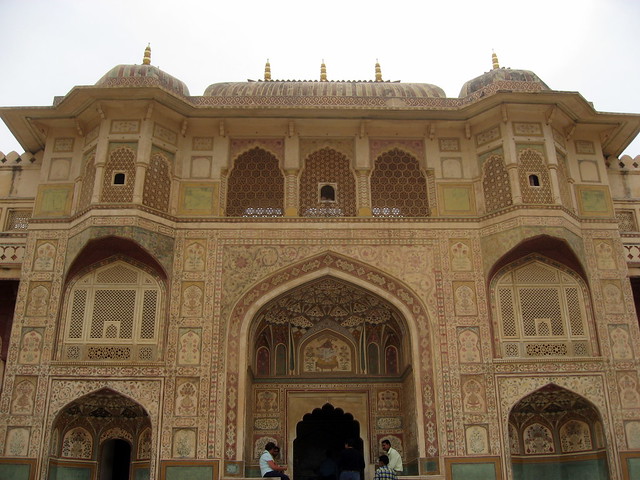
in English, Hindi and Telugu. (5) 11 km from Jaipur City the capital of Rajasthan is the sprawling Amber Fort in all its Rajput glory. With its unique artistic style it brings about a perfect blend of Hindu and Muslim architecture. Built in 16 the century by Raja Man Singh, the fort seems to grow out of the rugged hills with its mighty gates, temples, huge ornate halls, palaces, pavilions, gardens and even a ramp that takes you to the hilltop palace! Beautifully- caparisoned elephants go up and down carrying visitors to and fro making it a fascinating experience you cannot miss if you’re in Rajasthan. Amber Fort is divided into four sections. Each is accessible via large staircases from a central location, or from a broad pathway leading to each of the sections. The walls of the interior of the fort are covered lavishly with murals, frescoes, & paintings depicting various scenes from daily life. Other walls are covered with intricate carvings, mosaic, & minute mirror work that are splendid works
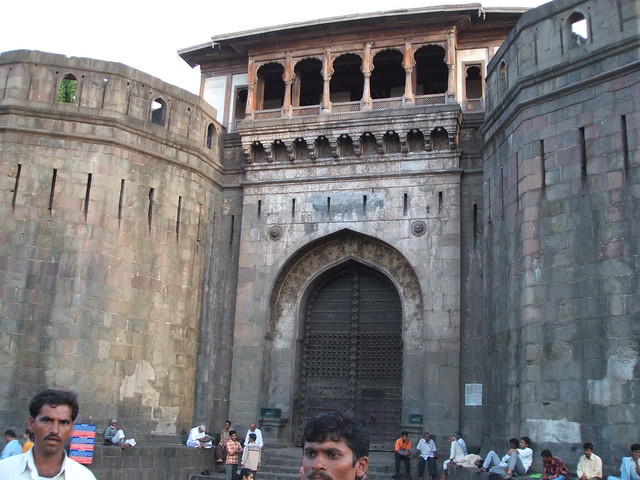
of art. (6) The Shaniwar Wada Palace Fort of the Maratha Dynasty lies in the heart of Pune city. It covers six and a quarter acres in central Pune. Constructed in 1732 as the seat of the Peshwa (prime ministers of the Maratha Empire) it remained the political capital of the Empire until its annihilation. While the Palace was destroyed in a big fire in 1827, the mammoth structure of the walls survived the fire. Shaniwar Wada is a real specimen of Maratha culture and the architectural design shows the influence of Mughal style and the feature of Maratha artistic styles. The 21 feet tall massive door of the palace known as Delhi Darwaza is one of the remains of
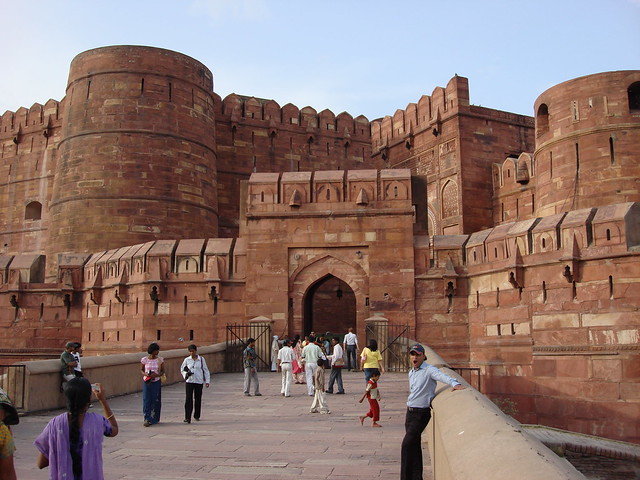
the grand old Palace. (7) It's a UNESCO World Heritage site, the Argra Fort about 2.5 km northwest of its much more famous sister monument, the Taj Mahal. The fort can be more accurately described as a walled palatial city. This brick Fort was held by the Rajputs and was home to the Sultan of Delhi. After he was killed in the battle of Panipat, the Mughals captured the fort and its vast treasure which included the diamond that was later named as the Koh-i-Nor diamond. The Fort includes a number of important buildings and sites including: The Jahangiri mahal built by Akbar for his son Jehangir, The Khas Mahal a white marble palace with beautiful paintings on the marble, The Musamman Burj - a large, octagonal tower with a balcony facing the Taj Mahal, Mina Masjid (Heavenly Mosque), Pearl Mosque, Nagina Masjid (Gem Mosque) a mosque especially designed for the ladies of the court, featuring the Zenana Mina Bazaar (Ladies Bazaar) Naubat Khana (Drum House), a place where the king's
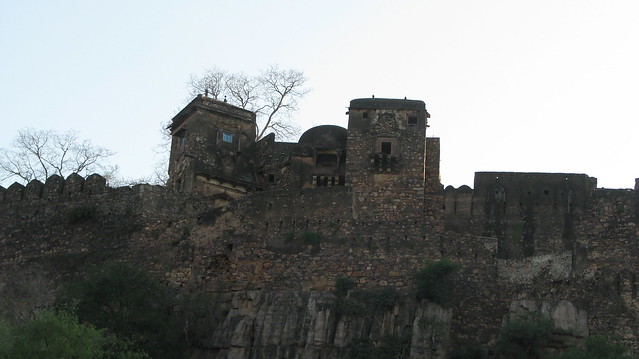
musicians played & lots more. (8) In the heart of the Ranthambhore Nation Parts lies a Colossal Fort surrounded by jungles built in 994AD by Sapaldaksh Chauhana to thwart invasions by Persian invaders. It went on to be taken over by the Rajputs and then the Mughals . Then came Alauddin Khilji, a ruler of Afghan descent. The Rajputs had mastered the art of guerilla warfare and countered to hold out against the Sultanate, but had not contended with Khilji’s military tactics. Alauddin Khilji captured Ranthambhore fort in 1303 and destroyed the temples within its walls. Having passed through the hands of so many dynasties the fort tells many tales. Today is visited by many because of its great location in the center of the National Park home to many varieties of India’s Wildlife including the much diminishing Bengal Tiger

(Indian Tiger). (9) The biggest fort in Asia, this Fort is situated on a hilltop near Chittor town in the Indian state of Rajasthan. It is one of the most historically significant forts not only of Rajasthan but of the whole of North India. This colossal fort covers an expanse of 700 acres. Perhaps the most remarkable feature of the palace fort is its splendid series of canopied balconies. The complex also houses stables for elephant and horses, but is now in ruins. This fort includes a number of temples like the Naulakha Bhandar (nine lakh treasury), the Shringar Chaori Jain Temple with detailed carvings of gods and goddesses on the outside, the Mira Bai Temple, the Brahma Temple and many more. The most imposing monuments in Chittor however are the dual towers that stand as a grim reminder of the jaded grandeur of Chittor.

(10) The gateways to the forts in Rajasthan were no mere entrances; they were massive, reinforced, stone structures built to withstand marauding armies, elephants and cannon volleys. They usually had notched parapets at the top, from where archers shot their arrows at the attacking army. Ahhichatragarh Fort has 3 main gates. The Sireh Pol was the outer gate fitted with iron spikes, which could stop the onrush of elephants and enemy soldiers. The Beech ka Pol was the second gate and the Kacheri Pol was the last, so called because it housed the judiciary in those ancient times. The gates and the strong impregnable walls enabled the warriors of the Ahhichatragarh Fort to withstand the battling hordes of successive covetous-rulers who looked to conquer the magnificent fort for its location & importance.
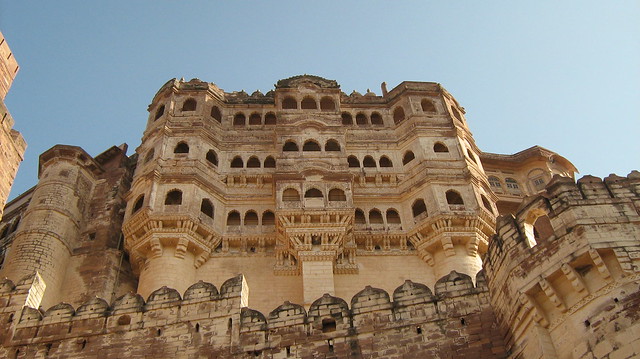
(11) The majestic Mehrangarh Fort is one of India's largest forts and located in the picturesque city of Jodhpur. The work of building the fort originally commenced in 1459 on the behest of the founder of Jodhpur - Rao Jodha but much of the fort as it stands today was built in the era of Jaswant Singh. This magnificent fort is spread over 5 kms. and is located on top of a hill which is all of 125 meters high. To honor and memorialize momentous triumphs there are three stately gates to the fort. Once inside the fort visitors can't help marveling at some astonishing palaces which are a living testimony to the high standard of craftsmanship prevalent in those days. The Moti Mahal which is made of elaborately carved stones is the dwelling place of the royal throne of Jodhpur which is popularly referred to as the Sringar Chowki in local parlance. There is also the majestic Umaid Villas that showcases some remarkable Rajasthani miniature art work. The Ajit Villa is conspicuous with its rich collection of musical instruments and regal attires while the gorgeous Phool Mahal is where the legendary Jodhpur Coat of Arms is preserved. The parapets of Phool Mahal are adorned with exquisite art works portraying various melodious scenes. For some bravado, one doesn't need to go far. There is the well preserved Maan Villas which exhibits the arsenal and weaponry of the house of Rathores. The intriguing Tent Room is fabulous which has distinct Mughal features. Legend has it that it was once used by Mughal emperor Shah Jahan. The tent is richly embroidered with gold and is literally a treat to the eyes. Mehrangarh fort has never ever been seized. The invincible fortifications are six meters thick. Some of the walls still bear cannon marks & today this magnificent Jodhpur fort is a living testimony that recounts the chronicles and legends of Jodhpur's rich past.
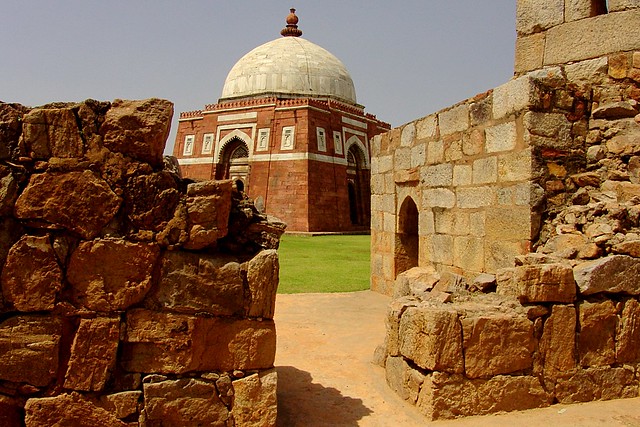
(12) Tughlaqabad Fort is in the outskirts of Delhi, aloof and secluded from public view. Very less remains of what once was a intimidating fort. The red stone fort was commissioned by Tughlaq emperor, Sultan Giyas-ud-Din Tughlaq in the year 1321 and was completed in the year 1325. It's very strange that a fort of such denomination as this was completed in just 4 years. This fort was build as a part of Tughlaqabad city, which is considered the 3rd city in Delhi of the sultanate era. The primary reason for building this fort was the then prevailing political and social unrest. The Mongols were on the rampage in the central Asia and were attracted to Delhi because of the stories about its grandeur, which at times were grossly exaggerated. They were doing heavy attacks on the Northwestern boarder of the sultanate and the outposts were finding themselves incapable to cope with the onslaught. This political instability made Giyas-ud-Din build a fort which was invincible and thus came Tughlaqabad in to existence. You can pretty well understand now that it was the pressing time which forced Tughlaq to build this fort in such a short span of time. A high raised part of the southern-ridge was selected for its construction. A raised platform was built as its plinth to provide it additional height. The fort is blessed with massive ramparts and bastions, which was built, keeping in mind the Mongol onslaught. The height of rampart varies from 15 to 30 meters from its base itself. If you include the height of plinth and ridge then it comes to be whooping 50 to 70 meters. The walls are the thickest you can find in any of the forts in India. At places it is 35 feet thick, but generally varies between 15 feet to 25 feet at most of the places. Surely it speaks volumes about the might and grandeur of the Sultanate. Within these high walls you can still find ruins of, double-storied bastions and massive assault towers. Besides it had numerous palaces, a grand mosque and meeting courtyards. The main city was on the eastern side of the palace. The other major attraction is the tomb of Ghiyas-ud-din Tughlaq, the man who built the city. It was built by the emperor himself in the year 1328. You will have to walk down towards the southern end of the fort to find this tomb. The tomb, enclosed in a courtyard which has high raised walls, is a masterpiece of the fusion architecture of Afghanistan and Central Asia. This invincible was never conquered by the marauding Mongols but it lost the battle against the nature. The city was abandoned within 5 years of its establishment due to the severe lack of water on the ridge.
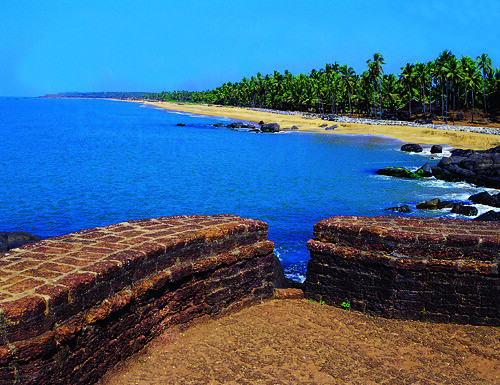
(13) Bekal Fort - Location : 16 kms south of Kasaragod town, Kasaragod District. Bekal Fort - Attraction : Giant keyhole shaped fort, the golden expanse of a beautiful beach surrounding the fort, backwaters and hill destinations and water sport facilities nearby. Bekal fort is the largest fort in Kasargod district, in the state of Kerala, India. The fort is spreading over forty acres. The fort is near about 350 years old and it is believed that, the fort was built in 1650 AD by Sivappa Naik of the Ikkeri dynasty. It is also believed that the fort was originally made by kolathiri Rajas and later captured by Sivappa Naik. The important features of this fort are the tank with its flight of steps, the tunnel opening towards the south, the magazine for keeping ammunition and the broad and wide steps leading to the Observation Tower which is a rarity. Bekal fort was not a center of administration for no remains of a palace is found within the Fort. It was built for fulfilling the defense requirements. The holes on the outer walls of the fort are so remarkable that they are specially designed to define the fort effectively. The fort faces the Arabian Sea. Bekal fort stands on a promontory between two long classically beautiful palm fringed beaches. The main attraction nearby the fort is Centuries old fort, virgin beaches, and pristine backwaters etc.
(14) A visit to Dabhoi Fort, located in Gujarat, India, coupled with an attendant visit to Tourism of Gujarat, informs a tourist that the fort is of immense value, both historically and beauty wise and the fort happens to be located near Darbhavati town, which is further situated in the Gujarat, India. Dabhoi Fort, located in Gujarat, is attributed to Siddharaj Jaisinh and the architectural style and the iconography present in the Dabhoi Fort, situated in Gujarat, India, is of immense value and it is apparent that it was conceived in the same time period as the forts of the order of Rudra Mahalaya and Zinzuwada Fort located in Gujarat, India. Dabhoi Fort, located in Gujarat, India, is mentioned in various historical texts and the Dabhoi Fort, located in Gujarat, India, is based on the lines of the various shastri traditions, which are mentioned in the various Vastu scriptures and tomes of ancient India. Dabhoi Fort, situated in Gujarat, India, also happens to be the birthplace of the great and popular Gujarati poet, known as Raskavi Dayaram in Gujarat, India. Then, this poet Raskavi Dayaram has composed various garbis which are the Gujarati devotional songs.

(15) Pavagadh Fort tands out as an exemplary historical monument, which is famous for its architectural brilliance. Pawagadh has equal importance to Hindus and Jains of the place. The earliest part of the Champaner compound, the Pavagadh fort was an important fortress of the Solanki kingdom. The walls of the fort are still standing in parts, as are parts of the earliest known Hindu temple, a Lakulisa temple dated to the 10th-11th century. Other Hindu and Jain temples dating to the 13th-15th centuries, are of the Nagara style.

(16) Fort St George was established in 1639 along the coast of the Bay of Bengal in Chennai city. It is often said that this marked the birth of the city. This monument is a great reminder of the East India Company. The fort has relics of its founders and leaders. It’s a great military marvel. Inside the Fort is the Fort museum which is decorated with cannons of Tipu Sultan. There are a lot of interesting artifacts showcased in the museum like coins, artifacts and so on. Today, Fort St George is famous for housing the legislative assembly and is known as the secretariat building. Various Government offices function inside this building, including the structure which used to be the residence of Robert Clive called the Clive House. The tallest flag pole in the country can be seen here, where the national flag flies proudly at a height of 150 feet. . The Pole is now made of metal was originally made entirely of teak wood. Apart from the museum, the southern division of the Archaeological Survey of India is located here. The place is famous for its exotic collection of books in the library. The St George Fort in Chennai also has a church of ST Mary’s which is the oldest surviving English Church in India. This monument is taken care by the Archaeological survey of India and hence is well preserved and maintained. It serves as a great centre for attraction as the origin of the city can be attributed to this building. A visit to Chennai is incomplete without getting a taste of the colonial heritage through this building.

(17) Fort Saint David, British stronghold near the city of Cuddalore, about 100 miles (160 km) south of Chennai (formerly Madras) on the southeastern coast of India. It was named for the patron saint of Wales because the governor of Madras at the time, Elihu Yale, was Welsh. In 1690 the Marathas sold the fort to the British East India Company. Because of increasing political instability in southern India, company officials found a second fortified trading station (besides that in Madras) to be desirable. In the 18th century the fort became a second centre of British power in southern India. In 1747–48, aided by the presence of a British fleet, it withstood a French attack after the fall of Madras. In 1758 it was taken by the French but was abandoned when the French city of Pondicherry (Puducherry) was attacked by the British. It was taken again by the French in 1782 but was restored to the British in 1785, and, with the end of the French threat, it was abandoned and fell into ruins.

(18) Gingee also pronounced, as "Shingee" is 37-km east of Thiruvannamalai. Gingee is famous for a fort complex dating back to 13th century, located on the 3 different hill summit covering 3-km boundary area. The Chola Dynasty built Gingee fort. The indomitable courage and valour of its erstwhile rulers made Father Pinments, a priest to call the Gingee Fort the "Troy of the East". The Vijayanagar emperors, Marathas and the Mughals occupied it after the Cholas and it was in the hands of the French and British rulers also for sometime. In 1638, Gingee went under control of Bijapur Sultanate from the hold of the Vijayanagar emperors. Then it went to Maratha hero Shivaji in 1677, to Mughal in 1690, to French in 1750 and to British in 1762. Vekataramana Temple is the largest temple in Gingee, which was built by Muthiah Nayaka in 1550 AD.

(19) This fort is located at a distance of 14kms. from Nagercoil. This was the vital military station of the Travancore rulers, when Padmanabapuram was capital of Travancore. It was stated to have been originally built in the year 1600 AD, and then Marthanda varma rebuilt it. It is stated that a brass gun of 16 feet long bored found inside the fort could not be moved even a few years by1200 persons with the help of 19 elephants. East India company's troops were stationed there till the middle of the 19th century. The fort enclosed with an area of about 90 acres and contains an isolated hill, which afford a panaromic view of the surrounding area. The tombs of Dalhousie, his wife and his son can be seen, inside a partly ruined chapel inside of the fort.

(20) Vellore Fort is situated in Vellore near Chennai in Tamil Nadu state, India and was built by the Nayakar captains of the Vijayanagara Empire and was constructed with large granite blocks. The fort is known for its grand walls, wide moat and robust masonry. The fort covers about 133 acres of area. It is believed to be the only stone fort in India. The fort houses a Temple, a Mosque and a Church, the reknown Vellore Christian Hospital, and many other buildings that are now used as public offices
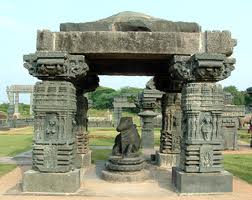
(21) In the early 13th century during the reign of Ganapatideva, the capital was moved from Hanamkonda to the new city of Warangal, which was laid out in a circular plan with three concentric rings of walls. The first ring which constitutes the Fort has high walls made of massive granite blocks laid without mortar. Inner faces of the walls have steps ascending to a path that runs along the top. Entrance gateways like the one seen here were renovated in Bahmani times as is clear from the sculpted fragments reused from dismantled temples. Here a temple ceiling fragment is placed in a niche. The image is of Vishnu carried by Garuda and surrounded by attendants. Above this some granite blocks are replaced by panels of elephants and yali.

(22) The fort at Chandragiri is an ancient fort which is made of hard laterite stones. It was built by the Sivappa Nayaka of Bednore in the 17th century A.D, who set-up his authority over the area and built a chain of forts. The Chandragiri river on which it rises marked the traditional boundary between kerala and Thuluva kingdom. The two sides of the chandragiri fort are facing the sea. The fort has an eventful history to relate... A couple of centuries ago, the river Chandragiri was considered the border of two powerful kingdoms - Kolathunadu and Thulunadu. When Thulunadu was captured by the Vijayanagara Emperor, the Kolathunadu kings lost the Chandragiri region to them. It was only in the 16th century that the great empire of Vijayanagara (presently under the Karnataka State) declined. But later the Ikkeri Naikkars or the Bedanoor Naiks took over the reins of Chandragiri as an independent region. Thus the Chandragiri Fort was built by Sivappa Naik for the defence of his kingdom. The fort changed hands over the years to Hyder Ali of Mysore and then to the British East India Company. Today it is a protected monument under the State Archaeology Department. The Chandragiri region was rejoined to the State of Kerala through the State Reorganisation Act, 1956, Government of India. There are eight view towers with peeranky holes from which the sea route can be guarded closely. The main watch tower is facing north. On the eastern and western side there are two underground passages. A deep well and a pond with flight of steps are there inside the fort. The fort with an area of 7.76 acres is now protected monument under the department of Archaeology. The ruins of the massive 17th century fort sprawled on the banks of the Chandragiri river is a place of immense importance to archaeology & history students.

(23) Kondapalli Fort is a wonderful tourist attraction located in a small village called Kondapalli. It is only at a distance of 16 km from Vijayawada city in Andhra Pradesh . This village is famous for its wonderful toys which are made from light-weight wood. The toys have a great demand in both national and international markets. Kondapalli Fort is located 16 km away towards West from Vijayawada City and is built on a hill. Prolaya Vema Reddy, build this fort during 14th Century. Later came under the rule of the Qutubshahis who strengthened and eloborated by totaling new structures. The Kondapalli fort is located in Kondapalli village in Krishna District of Andhra Pradesh. The fort has glorious history. The fort gives the proof of many families. The fort was built in 14th century. The fort was constructed by Prolaya Vema Reddy of kodaveedu. After that the fort came under the control of Qutub Shahis and they repaired it. Actually this fort was constructed in Kondapalli village which is at 16 km in the west of the city of Vijayawada. Relaxation and the entertaining are the main purpose of the fort. The fort built on the hill which is in the Krishna District. There is one three-storied rock tower. Also there are dargah of a Persian saint, Gareeb Saheeb. These are the attraction points in the fort. Right now tourism development is responsible for the maintenance of the fort. Also there is one Gajasala that is the place of elephant. Elephant stay in it. One can see the remnants of central fort and the jails of that time. The fort is located in Krishna District. The fort is at 16 km away from the Vijayawada city. And this Vijayawada city is around 275 km away from the Hyderabad city. Hyderabad is one of the important and well connected city so one can easily reach at Hyderabad. There are lots of buses and trains are available form all other cities. One can easily reach at fort from Vijayawada. The frequency of buses from the Vijayawada city is good. Also there are private cabs are available.

(24) Another heritage site in Karnataka which dates back to 12th century is located in the city of Belgaum, the Belgaum fort. It was originally built by Jaya Raya, also called Bichi Raja, in the year 1204 AD who was an ally of the Ratta Dynasty. This beautiful fort is located in a picturesque location in the foothills of Sahyadri Mountains and on the bank of Markandeya River. A major significance of this fort is that Mahatma Gandhi was imprisoned in this fort during the freedom struggles. Belgaum city was once the capital of the Ratta dynasty. Later, it was invaded by several emperors like Vijayanagara emperors, the Bahmanis, Marathas and finally by the British. The fort is oval shaped and the construction of this fort can be considered one of the finest examples of Indian architecture. The devotional places inside the fortress shows cultural unification as they show Hindu, Jain and Muslim architectural influences. The Jain temples Kamal Bassdi and Chikki Basadi are must see monuments here as they are the oldest and built in Chalukyan style. Safa Masjid and Jamia Masjid are mosques which show a fusion of Nagari and Persian styles. Two Hindu shrines can be seen at the fort entrance devoted to Lord Ganesha and Goddess Durga. This ancient mounument is situated in Belgaum which falls on NH 4 and NH 4A. The nearest cities are Dharwar-70 KM and Hubli-94 KM

(25) Devanahalli Fort is one of the oldest forts in Karnataka which was built in 1501 by Mallabairegowda. The fort was passed on into many hands and the current fort which we see was built by Hyder Ali and Tipu Sultan. Khas bagh is a major place to see near this fort, the birth place of the Tiger of Mysore, great Tipu Sultan. It is located 150 m south-west outside the fort. The palace where Hyder Ali and Tipu Sultan resided can also be seen here. The Venugopalaswamy Temple inside the fortress is the oldest temple among the many temples inside Devanahalli fort. The sculptures seen here is similar to Belur and Halebid. Dravidian style and Vijayanagara style statues and stone carvings are another peculiarity of the temples here. This vast fortress is spread over 20 acres and located on NH 7 in Devanahalli, 35 km away from Bangalore city.

(26) The 12th century fort, Basavakayana is one of the most ancient forts in the state. The historical town of Basavakalan is known for its archaeological splendor and the fort is set right in the middle of all that beauty. The place which used to have tall erect structures with red polished bricks and wood works is not reduced to majestic ruins. The place is however an archaeological splendor with several artifact and sculptures being excavated from here.

(27) This 15th century structure situated in the heart of the garden city is a very famous tourist location which captures the real feel of the region which had seen many battles. The fort is constructed in red rock and hence a beauty to just look at. The intricate battlement and baronial gateways will take you to a time back in history where survival was difficult. For the home lovers among you the ancient royal baths and spacious kitchens and large audience halls would be of interest. The beautifully carved wooden pillars of the fort would be the thing that will catch your eye first. There are Persian couplets which were inscribed to the post. And those mother of pearl inlay works are not to be missed when here.

(28) The fort which was quite dear to Tipu Sultan’s heart has a cannon at its southern end which was place there by his very hands. Set above the most picturesque country locations this fort is the place you would want to visit to spend some time in peace and quiet. For the spiritual among you the fort could be a pilgrim location as the place is dotted with temples. One of the most important temples to visit when here would be the Shivalaya Temple which is one of the ancient Chalukyan Temples. The Jambulinga Temple and the Bhutanath Temples are the famous cave temples near this fort. When here also visit the archaeological museum in its premises as it has several ancient scriptures-relics which can take you way back into the past

(29) The fort set atop Ballari Gudda was built in 1769. The monument and its serene location would be the ideal place for some exploration. The upper portion of the fort is polygonal structure with many an entrance. The lower portion is the place for arsenal and barracks from where more of the warfare took place. When on a trip to the place do go in your trekking shoes one will get a chance to go up a long windy climb through narrow mud paths to reach the upper forts. The temple on top of the fort is supposed to have lucky charms. The lower part of the fort has the famous Kote Anjaneya temple. When here, do stay on till the dusk as the fort is lit completely during the nights. A stretch of 2 km is illuminated by 188 special lights in the night.
 (30) A structure which extends over 38,000 square yards Gulbarga fort is an archaeologist’s heaven. For those interested in long exploratory strolls, Gulbarga is the monument to visit. The main attractions of the fort include beautiful mosques with exquisite wood and stone work. Jumma Masjid built as per the Persian style of architecture is one of the best Islamic structures in the country itself. Representing the cultural richness in the state there are Hindu temples within the structure along with Muslim ones. The ammunition dumps, stables and ancient carriages are the things to look for in your exploration. Do walk down those hallways, secret passages and grand edifices to get a true feel of the region’s ancient history. What one should not miss when on a visit to the place are the 15 towers and 16 guns preserved for public view.  (31) A massive stone fort set on top of the Chitradurga Hill, the fort is one of the best places to visit when on a sunset hunt. The serene view from top of the fort will clam your senses. Located just 200 km from the garden city, Bangalore, the fort was built by the Nayakas of Chitradurga. For those interested in going on an expedition into the past this is the fort to visit as the structure with 19 gate ways is one huge structure. To add to the mystery there are four secret entrances to the fort and 38 posterior entrances. Also the palace which is hidden and used to be guarded by the fort is a magnificent site to see. The fort is also known for its scenic view as it is surrounded by lush green forests dotted with ancient temples. Ekanatha Temple, Hidimbeswara Temple and Chandravalli Caves should be visited when here.  (32) Located in the Belgaum district of the state is a fort built in all its majestic glory by Queen Chennamma of Kittur . Displaying the valor of the queen herself, the fort built hundreds of years ago still stands erect in all its majestic glory. For those among you who are interested in stepping into the past to see its shadowy corridors this fort which is also an archaeological site is the best place to visit. The fort once had a 100 ft high porch which is now reduced to ruins. But even the majestic splendor of the ruins is a worthy site to see. For the star gazers among you, the fort would be the ideal place to visit as there is an ancient telescope inside it through which the Queen used to gaze at the pole star every morning.
(33) One of the most powerful leaders of the time, Tipu Sultan was known for his valor. And one of the forts which protected this mighty ruler is the Tipu’s Fort which is built right in the middle of the garden city, Bangalore. Standing right opposite to the city market the fort offers one the bird’s eye view of the city. The original structure of the fort was built in 1537 and the current form is only the outer wall of the once strong Tipu’s Fort. When here do not forget to visit the palace protected by the structure as the architecture in display is par excellence. The fort follows Islamic style of construction and it has beautiful carvings on its gate walls.

(34) The fort of Maharani Jhansi has strategic importance since the earliest of times. It was built by Raja Bir Singh Ju Deo (1606-27) of Orchha on a rocky hill called Bangra in the town of Balwantnagar (presently known as Jhansi). The fort has ten gates ( Darwaza) .Some of these are Khandero Gate, Datia Darwaza, Unnao gate, Jharna Gate, Laxmi Gate, Sagar Gate, Orcha Gate, Sainyar Gate, Chand gate. Among places of interest within the main fort area are the Karak Bijli Toup ( Tank), Rani Jhansi Garden, Shiv temple and a "Mazar" of Ghulam Gaus Khan, Moti Bai and Khuda Baksh . The Jhansi fort, a living testimony of ancient glamor and valour, also has a fine collection of sculptures which provide an excellent inside into the eventful history of Bundelkhand

(35) The Rohtasgarh Fort located in Rohtas district is 45 km far from Dehri and 39 km away from Sasaram. This fort is situated on the top of the Kaimur Hills. It got its name from mythological character Rohitashwa, the son of King Harischandra. The king stayed in this fort in exile for several years realizing danger to his life. On the top of the hill the Fort is constructed on a plateau at a height of 1500 ft above the sea level. There are about 2000 limestone cut steps from the foothill to the top. After the end of these steps there is a gate which is the first gate to the fort. From this gate Rohtas Fort lies at a distance of 2km from this gate. The Rohtas fort is an outstanding example of Mughal architectural style. Once one the largest and strongest fort in India now is in ruins. History of Rohtas Fort is very long and interesting. Although the exact origin of the Rohtas fort is lost in history, the earliest monuments here dated back to king Sashanka of seventh century AD. In mediaeval times this fort was captured by Prithviraj Chauhan. However this fort rose to prominence only after captured by Sher Shah Suri in 1539 from a Hindu king. During the Sher Shah's reign 10000-armed men guarded the fort. During Sher Shah rule a Jama Masjid was built in this complex by Haibat Khan a soldier of Sher Shah. This fort came under Man Singh, Akbar’s General in 1588. He built a palace for himself inside the fort complex which is known as Takhte Badshahi. He also built Aina Mahal a palace for his main wife and Hathiya Pol the main gate of the Fort. There are other structures outside the palace like Jami Masjid, Habsh Khan's Mausoleum and the Makbara of Shufi Sultan. About half a kilometers west of Man Singh's Palace is a Ganesh temple which was built in Rajputana style of architecture. After battle of Buxar the British captured the fort and destroyed most part of it. Spreading across for 4 miles in east-west and for 5 miles in north-south direction this fort was an invincible one owing to its inaccessible location and defenses. Militarily the fort has a strategic location being on the top of a steep sided hill. The presence of various Hindu and Islamic structures within the prec

(36)Fort Vishal was named after King Vishal of Vaishali in Bihar, India. This marvelous archeological ancient shrine is basically an excavated site in Vaishali, Bihar. This one kilometer lengthy Fort Vishal is believed to be the remains of an ancient parliament house, of the Lichhivis where these people used to discuss and regulate the ancient republic. Hence the Fort Vishal is known as the element of the oldest democracy in the world. An architectural marvel, Fort Vishal is worth visiting. Apart from the fort, the museum of Vaishali is worth visiting. This museum has some of the excavated artifacts from Vaishali. Then there are the Stupas, Abhishek Pushkarni and the Dargah of Miran ji are some of the tourist places in Vaishali. The stupas found in Vaishali had stone caskets which contained the ashes of Buddha. About the Abhishek Pushkarni is said that a king anoint with the water of this tank

before his coronation. (37) The Munger Fort, located at Munger in the state of Bihar, India. One of the most important monuments at Munger is the ancient fort. This monument has been built in a rocky ambience, projecting into river Ganges. Its barricade has four gateways, one on each side. of all the gates, only the northern gate, called Lal Darwaza, is a bit preserved, with some carved stones built into it, which initially belonged to some Hindu or Buddhist structure. All the others are now mostly

into ruins, but still worth seeing. (38) Barabati Fort, situated in Cuttack, is one of the most sought-after tourist attractions of Orissa. Situated on the bank of Mahanadi River, this fort lies on the western side of the city. It is located at a distance of about 8 km from the heart of Cuttack. Barabati fort once housed an illustrious nine-storied palace. The local authorities have now taken over the task of maintaining this royal structure. Barabati fort is spread over an area of 102 acres. The moat of the fort, more popularly known as Gadakhai, is a 20-yards wide ditch. The fort was initially constructed around the eleventh century and was later reestablished during the fourteenth century. Archaeological excavations carried at Barabati fort suggest that the walls that enclosed this magnificent monument once were made from laterite and sandstone. The gateway of the fort is totally splendid and stands embellished with beautiful intricate carvings. The moat of Barabati fort, along with its elaborately carved gateway and the earthen mound, speaks of the glorious past of the Ganga dynasty. The fort has undergone a lot of transformation since its construction. Its interiors have been converted into a stadium, which has the capacity to hold more than 30,000 persons at a time. Since its inception, it has been serving as the venue of
 sports contests & cultural events. (39) Bundi, a picturesque little town of the desert state of Rajasthan, well off the beaten tourist track, houses the massive Taragarh Fort. One of the most notable forts of Rajasthan, Taragarh Fort draws millions of visitors from worldwide each year. Constructed in the year of 1372 AD, this grand fort was the home of a major princely state at the height of the Rajput heydays. A steep road will lead you to the entrance of the fort, where elephants placed atop the gate will greet you. In fact, there are three entrances of the fort known as Lakshmi Pol, Phuta Darwaza and Gagudi ki Phatak. Taragarh fort has some unique tunnels crisscrossing the entire hillside which were used by the royal personnels to flee in case there was an imminent danger to their lives from enemies. As you enter inside the fort complex a number of wonders will mesmerize you with their marvellous architectural design. While exploring the fort you will find the water reservoirs, Bhim Burj and the Rani Mahal on your way. Besides, from the fort, you can have an excellent breathtaking view of the town. Water Reservoirs : Inside the fort see the huge water reservoirs, built of solid rocks. It is believed that these reservoirs were constructed for water storage and to supply water to the needy during time of crisis. It is also said that if these reservoirs were released in full force, the water had the capacity to wash away the people residing beneath. Bhim Burj and Garbha Gunjan : Bhim Burj is another attraction of the Taragarh Fort. A massive stone tower which houses the second largest canon of mediaeval India, named Garbha Gunjan. Rani Mahal : Although it is too small in shape, but it will mesmerize you with its spectacular murals and stained glass windows. Situated withing the fort complex, Rani Mahal was built for the wives and  concubines of rulers. (40) Gagron Fort is a fortress located approximately 10km north-east of Jhalawar, at the confluence of the Ahu River and the Kali Sindh River. It covers the entire stretch of a plateau on a steep outcrop of the Vindhyan Hill Range, which measures 23 hectares and is surrounded by a buffer zone of 722 hectares. Gagron Fort is so obscure but at the same time it is such an outstanding embodiment of great architecture in terms of design,structure and strategy coupled with the bravery and chivalry of the erstwhile Rajput Rulers and  warriors (41) Kumbhalgarh is a tourist spot of 'Rajasthan State' in India.The main attractions of Kumbhalgarh are the 'Kumbhalgarh Fort' and 'The wild life Sanctuary' existing there. The Kumbhalgarh Fort is a 15th century Fort constructed by Maharana Kumbha which covers an area of 12 square kilometers.The fort is encircled by thirteen elevated mountain peaks of the Aravali ranges. It is made on the top most ridges about 1100 meters above sea level.The whole place situated away from the city crowds and busy traffic in a serene beautiful locality will be liked by tourists.Kumbhalgarh Fort is located approximately 105 kilometers northwest of Udaipur City and the Udaipur Airport is 85 km away. It is situated in Rajsamand District.The dominion of Maharana Kumbha extended up to Gwalior and Ranthambore.He constructed this Fort where there existed a Citadel dating back to the second centuary A.D. built by a Jain descendant of Mauryan Empire. The fort is massive and it is second to the eminent Chittaurgarh Fort.The walls of the fort is 36 km long and it is 7 meter wide.This fort remained unconquered till to date because of its unique location and solid construction.It but fell once to the combined forces of  (42) Mughal and Amber because of scarcity of water. The 19th Centuary Maharana, Fateh Singh renovated it.Now this fort encloses another fort in its complex which is known as 'Kartargarh Fort' and comprises of a Palace built by Maharana Fateh Singh.This Palace was built by him after demolishing a palace existed there which was built by Rana Kumbha.In the Kumbhalgarh Fort there are 365 temples which belongs to Jains as well as Hindus. The fort complex has many palaces and the magnificent one is 'Badal Palace'(Palace of Clouds) which is situated in a high altitude and seems to be situated among the clouds.A bird's eye view from there is a splendid sight. Apart from Palaces,temples etc the complex have fields,water resources etc which were sufficient to withstand all type of emergencies. The Fort served the rulers of Mewar as a refuge in times of strife.It served as a refuge for baby King 'Uday' of Mewar.Another historical fact is that 'Badal Palace' was the birth place of Maharana Pratap. The fort has seven massive gates and several watch towers.The wall which circumvents for 36 km is world's third longest one which is 7 meters wide. After entering the main gate the scenery on the way which winds up to the pinnacle in a comparatively quiet atmosphere is but enriched with greenery and gardens.The view of the surroundings is breathtaking and enchanting. The wild life sanctuary at Kumbhalgarh is stretched to 578 square kilometers. Animals such as leopards,Sloth Bears,Wolves,Jackals,Deer etc can be spotted here.Jungle treks and Safaris are arranged by the authorities for the tourists. There are comfortable hotels available for a night stay at Kumbhalgarh. Udaipur City is 105 km away,Jaipur City is 318 km away and Jodhpur is 171 km away.Udaipur is well connected to all major cities by road and rail,  (43) Kalinjar Fort: Situated at a height of 700 ft. on the Vindhya ranges, this fort is accessible through seven gateways-the Alamgir Darwaza, Ganesh Dwar, Chauburji Darwaza, Buddha Bhadra Darwaza, Hanuman Dwar, Lal Darwaza and Bara Darwaza. Within the fort are two palaces-the Raja Mahal and the Rani Mahal, as well as several other places of interest. These include Sita Sej, a small cave containing a stone bed and pillow once used by hermits; a reservoir known as Patal Ganga; Pandu-Kund, where water trickles from the horizontal crevices of stratified rocks; Buddha-Budhi taal, whose waters are believed to possess healing qualities; Bhairon-ki-Jharia or Manduk Bhairon; the Mrigdhara or Antelope’s spring situated within an inner chamber of the rampart, and Koito Birth, which is an important place of pilgrimage where lepers are believed to be cured. Source:bestplaces-topplaces.blogspot.com/, taragarhfort.blogspot.in, en.wikipedia.org, arki-travel.blogspot.in, sortingdiamondsandpearls.blogspot.com, Remark: Copy images url and paste to find it’s source of sharing, also get connect with each source of sharing articles via specified links. Our Sites unique and other links (if there will be any) are available just for the requirement of the subject not for increasing circulations, as we are not in the promotion of any kind its all for very special issues, personalities etc. |

